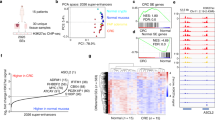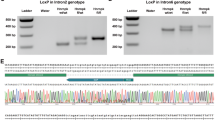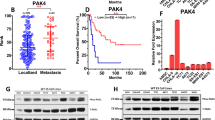Abstract
Pak1 (serine/threonine p21-activated kinases) was previously reported to have oncogenic activity in several cancers. However, its roles in the cancer microenvironment are poorly understood. We demonstrated that Pak1 expression in Langerhans cells (LCs) is essential for the maintenance of epidermal stem cells and skin tumor development. We found that PAK1 is localized in LCs by immunohistochemistry. Furthermore, the number of LCs significantly decreased in MSM/Ms Pak1 homozygous knockout mice (MSM/Ms-Pak1-/-). F1 hybrid (FVB/N×MSM/Ms) Pak1 heterozygous knockout mice (F1-Pak1+/-) had increased numbers of Th17 cells in the skin. Therefore, Pak1 knockdown cells were prepared using LC-derived XS52 cells (XS52-Pak1KD) and co-cultured with keratinocyte-derived C5N cells. As a result, XS52-Pak1KD cell supernatants promoted C5N cell proliferation. We then carried out DMBA/TPA skin carcinogenesis experiments using F1-Pak1+/- mice. Of note, F1-Pak1+/- mice exhibited stronger resistance to skin tumors than control mice. F1-Pak1+/- mice had fewer epidermal stem cells in the skin bulge. Our study suggested that Pak1 regulates the epidermal stem cell number by changing the properties of LCs and functions in skin carcinogenesis. We clarified a novel role of Pak1 in regulating LCs as a potential therapeutic target in skin immune disease and carcinogenesis.
This is a preview of subscription content, access via your institution
Access options
Subscribe to this journal
Receive 50 print issues and online access
$259.00 per year
only $5.18 per issue
Buy this article
- Purchase on SpringerLink
- Instant access to full article PDF
Prices may be subject to local taxes which are calculated during checkout







Similar content being viewed by others
References
Kim E, Youn H, Kwon T, Son B, Kang J, Yang HJ. et al. PAK1 tyrosine phosphorylation is required to induce epithelial-mesenchymal transition and radioresistance in lung cancer cells. Cancer Res. 2014;74:5520–31. https://doi.org/10.1158/0008-5472.CAN-14-0735.
Zhu G, Wang Y, Huang B, Liang J, Ding Y, Xu A, et al. A, Rac1/PAK1 cascade controls β-catenin activation in colon cancer cells. Oncogene. 2012;31:1001–12. https://doi.org/10.1038/onc.2011.294
Wong LL, Lam IP, Wong TY, Lai WL, Liu HF, Yeung LL, et al. IPA-3 inhibits the growth of liver cancer cells by suppressing PAK1 and NF-κB activation. PLoS ONE. 2013;8:e68843 https://doi.org/10.1371/journal.pone.0068843
Gonzalez-Villasana V, Fuentes-Mattei E, Ivan C, Dalton HJ, Rodriguez-Aguayo C, Fernandez-de Thomas RJ, et al. Rac1/Pak1/p38/MMP-2 axis regulates angiogenesis in ovarian. Cancer. 2015;21:2127–37. https://doi.org/10.1158/1078-0432.CCR-14-2279
Yeo D, He H, Baldwin GS, Nikfarjam M. The role of p21-activated kinases in pancreatic cancer. Pancreas. 2015;44:363–9. https://doi.org/10.1097/MPA.0000000000000276
Guo Y, Zhang Z, Wei H, Wang J, Lv J, Zhang K, et al. Cytotoxic necrotizing factor 1 promotes prostate cancer progression through activating the Cdc42-PAK1 axis. J Pathol. 2017;243:208–19. https://doi.org/10.1002/path.4940
He H, Baldwin GS. p21-activated kinases and gastrointestinal cancer. Biochim Biophys Acta. 2013;1833:33–9. https://doi.org/10.1016/j.bbamcr.2012.10.015
Chow HY, Jubb AM, Koch JN, Jaffer ZM, Stepanova D, Campbell DA, et al. p21-Activated kinase 1 is required for efficient tumor formation and progression in a Ras-mediated skin cancer model. Cancer Res. 2012;72:5966–75. https://doi.org/10.1158/0008-5472.CAN-12-2246
Jagadeeshan S, Subramanian A, Tentu S, Beesetti S, Singhal M, Raghavan S, et al. P21-activated kinase 1 (Pak1) signaling influences therapeutic outcome in pancreatic cancer. Ann Oncol. 2016;27:1546–56. https://doi.org/10.1093/annonc/mdw184
Huynh N, Shulkes A, Baldwin G, He H. Up-regulation of stem cell markers by P21-activated kinase 1 contributes to 5-fluorouracil resistance of colorectal cancer. Cancer Biol Ther. 2016;17:813–23. https://doi.org/10.1080/15384047.2016.1195045.
Huynh N, Wang K, Yim M, Dumesny CJ, Sandrin MS, Baldwin GS, et al. Depletion of p21-activated kinase 1 up-regulates the immune system of APC∆14/+ mice and inhibits intestinal tumorigenesis. BMC Cancer. 2017;17:431. https://doi.org/10.1186/s12885-017-3432-0. 19
Wang K, Huynh N, Wang X, Baldwin G, Nikfarjam M, He H. Inhibition of p21 activated kinase enhances tumour immune response and sensitizes pancreatic cancer to gemcitabine. Int J Oncol. 2018;52:261–9. https://doi.org/10.3892/ijo.2017.4193
Guo F, Hildeman D, Tripathi P, Velu CS, Grimes HL, Zheng Y. Coordination of IL-7 receptor and T-cell receptor signaling by cell-division cycle 42 in T-cell homeostasis. Proc Natl Acad Sci USA. 2010;107:18505–10. https://doi.org/10.1073/pnas.1010249107
Zhang W, Liu H, Liu W, Liu Y, Xu J. Polycomb-mediated loss of microRNA let-7c determines inflammatory macrophage polarization via PAK1-dependent NF-κB pathway. Cell Death Differ. 2015;22:287–97. https://doi.org/10.1038/cdd.2014.142
Gan J, Ke X, Jiang J, Dong H, Yao Z, Lin Y, et al. Growth hormone-releasing hormone receptor antagonists inhibit human gastric cancer through downregulation of PAK1-STAT3/NF-κB signaling. Proc Natl Acad Sci USA. 2016;113:14745–50. https://doi.org/10.1073/pnas.1618582114
Kaplan DH. Ontogeny and function of murine epidermal Langerhans cells. Nat Immunol. 2017;18:1068–75. https://doi.org/10.1038/ni.3815
van de Ven R, van den Hout MF, Lindenberg JJ, Sluijter BJ, van Leeuwen PA, Lougheed SM, et al. Characterization of four conventional dendritic cell subsets in human skin-draining lymph nodes in relation to T-cell activation. Blood. 2011;118:2502–10. https://doi.org/10.1182/blood-2011-03-344838
Cipolat S, Hoste E, Natsuga K, Quist SR, Watt FM. Epidermal barrier defects link atopic dermatitis with altered skin cancer susceptibility. Elife. 2014;3:e01888. https://doi.org/10.7554/eLife.01888. Published 2014 May 5
Kemp CJ. Multistep skin cancer in mice as a model to study the evolution of cancer cells. Semin Cancer Biol. 2005;15:460–73. https://doi.org/10.1016/j.semcancer.2005.06.003
Abel EL, Angel JM, Kiguchi K, DiGiovanni J. Multi-stage chemical carcinogenesis in mouse skin: fundamentals and applications. Nat Protoc. 2009;4:1350–62. https://doi.org/10.1038/nprot.2009.120
Singh A, Singh A, Bauer SJ, Wheeler DL, Havighurst TC, Kim K, et al. Genetic deletion of TNFα inhibits ultraviolet radiation-induced development of cutaneous squamous cell carcinomas in PKCε transgenic mice via inhibition of cell survival signals. Carcinogenesis. 2016;37:72–80. https://doi.org/10.1093/carcin/bgv162
Moore RJ, Owens DM, Stamp G, Arnott C, Burke F, East N, et al. Mice deficient in tumor necrosis factor-alpha are resistant to skin carcinogenesis [published correction appears in Nat Med 1999 Sep;5(9):1087]. Nat Med. 1999;5:828–31. https://doi.org/10.1038/10552
Cataisson C, Salcedo R, Hakim S, Moffitt BA, Wright L, Yi M, et al. IL-1R-MyD88 signaling in keratinocyte transformation and carcinogenesis. J Exp Med. 2012;209:1689–702. https://doi.org/10.1084/jem.20101355
Wang L, Yi T, Zhang W, Pardoll DM, Yu H. IL-17 enhances tumor development in carcinogen-induced skin cancer. Cancer Res. 2010;70:10112–20. https://doi.org/10.1158/0008-5472.CAN-10-0775
Forcales SV, Albini S, Giordani L, Malecova B, Cignolo L, Chernov A, et al. Signal-dependent incorporation of MyoD-BAF60c into Brg1-based SWI/SNF chromatin-remodelling complex. EMBO J. 2012;31:301–16. https://doi.org/10.1038/emboj.2011.391
Nardinocchi L, Sonego G, Passarelli F, Avitabile S, Scarponi C, Failla CM, et al. Interleukin-17 and interleukin-22 promote tumor progression in human nonmelanoma skin cancer. Eur J Immunol. 2015;45:922–31. https://doi.org/10.1002/eji.201445052
Langowski JL, Zhang X, Wu L, Mattson JD, Chen T, Smith K, et al. IL-23 promotes tumour incidence and growth. Nature. 2006;442:461–5. https://doi.org/10.1038/nature04808
Go C, Li P, Wang XJ. Blocking transforming growth factor beta signaling in transgenic epidermis accelerates chemical carcinogenesis: a mechanism associated with increased angiogenesis. Cancer Res. 1999;59:2861–8.
Seoane J, Gomis RR. TGF-β family signaling in tumor suppression and cancer progression. Cold Spring Harb Perspect Biol. 2017;9:a022277. https://doi.org/10.1101/cshperspect.a022277
Gorelik L, Flavell RA. Immune-mediated eradication of tumors through the blockade of transforming growth factor-beta signaling in T cells. Nat Med. 2001;7:1118–22. https://doi.org/10.1038/nm1001-1118
Modi BG, Neustadter J, Binda E, Lewis J, Filler RB, Roberts SJ, et al. Langerhans cells facilitate epithelial DNA damage and squamous cell carcinoma. Science. 2012;335:104–8. https://doi.org/10.1126/science.1211600
Lewis JM, Bürgler CD, Fraser JA, Liao H, Golubets K, Kucher CL, et al. Mechanisms of chemical cooperative carcinogenesis by epidermal Langerhans cells. J Investig Dermatol. 2015;135:1405–14. https://doi.org/10.1038/jid.2014.411
Ortner D, Tripp CH, Komenda K, Dubrac S, Zelger B, Hermann M, et al. Langerhans cells and NK cells cooperate in the inhibition of chemical skin carcinogenesis. Oncoimmunology. 2016;6:e1260215. https://doi.org/10.1080/2162402X.2016.1260215
Okumura K, Saito M, Isogai E, Miura I, Wakana S, Kominami R, et al. Congenic mapping and allele-specific alteration analysis of Stmm1 locus conferring resistance to early-stage chemically induced skin papillomas. PLoS ONE. 2014;9:e97201 https://doi.org/10.1371/journal.pone.0097201
Clausen BE, Grabbe S. Multifaceted contributions of epidermal langerhans cells to cutaneous carcinogenesis. J Investig Dermatol. 2015;135:1218–20. https://doi.org/10.1038/jid.2014.520
Schwarz T, Schwarz A. Molecular mechanisms of ultraviolet radiation-induced immunosuppression. Eur J Cell Biol. 2011;90:560–4. https://doi.org/10.1016/j.ejcb.2010.09.011
Jantschitsch C, Weichenthal M, Proksch E, Schwarz T, Schwarz AIL-12. and IL-23 affect photocarcinogenesis differently. J Investig Dermatol. 2012;132:1479–86. https://doi.org/10.1038/jid.2011.469
Nagao K, Kobayashi T, Moro K, Ohyama M, Adachi T, Kitashima DY, et al. Stress-induced production of chemokines by hair follicles regulates the trafficking of dendritic cells in skin. Nat Immunol. 2012;13:744–52. https://doi.org/10.1038/ni.2353
Kumar R, Sanawar R, Li X, Li F. Structure, biochemistry, and biology of PAK kinases. Gene. 2017;605:20–31. https://doi.org/10.1016/j.gene.2016.12.014
Kelly ML, Chernoff J. Mouse models of PAK function. Cell Logist. 2012;2:84–88. https://doi.org/10.4161/cl.21381.
Allen JD, Jaffer ZM, Park SJ, Burgin S, Hofmann C, Sells MA, et al. p21-activated kinase regulates mast cell degranulation via effects on calcium mobilization and cytoskeletal dynamics. Blood. 2009;113:2695–705. https://doi.org/10.1182/blood-2008-06-160861
Luckashenak N, Wähe A, Breit K, Brakebusch C, Brocker T. Rho-family GTPase Cdc42 controls migration of Langerhans cells in vivo. J Immunol. 2013;190:27–35. https://doi.org/10.4049/jimmunol.1201082.
García-García E, Rosales R, Rosales C. Phosphatidylinositol 3-kinase and extracellular signal-regulated kinase are recruited for Fc receptor-mediated phagocytosis during monocyte-to-macrophage differentiation. J Leukoc Biol. 2002;72:107–14.
Tran G, Huynh TN, Paller AS. Langerhans cell histiocytosis: a neoplastic disorder driven by Ras-ERK pathway mutations. J Am Acad Dermatol. 2018;78:579–590.e4. https://doi.org/10.1016/j.jaad.2017.09.022
Beesetti S, Surabhi RP, Rayala SK, Venkatraman G. Mechanics of PAK1-A new molecular player in the arena of skin cancer. J Cell Physiol. 2018;234:969–75. https://doi.org/10.1002/jcp.26925
Di Cesare A, Di Meglio P, Nestle FO. The IL-23/Th17 axis in the immunopathogenesis of psoriasis. J Investig Dermatol. 2009;129:1339–50. https://doi.org/10.1038/jid.2009.59
Müller G, Lübow C, Weindl G. Lysosomotropic beta blockers induce oxidative stress and IL23A production in Langerhans cells. Autophagy. 2019;1–16. https://doi.org/10.1080/15548627.2019.1686728.
Wang A, Bai Y. Dendritic cells: the driver of psoriasis. J Dermatol. 2019;10.1111/1346-8138.15184. https://doi.org/10.1111/1346-8138.15184
Eaton LH, Mellody KT, Pilkington SM, Dearman RJ, Kimber I, Griffiths CEM. Impaired Langerhans cell migration in psoriasis is due to an altered keratinocyte phenotype induced by interleukin-17. Br J Dermatol. 2018;178:1364–72. https://doi.org/10.1111/bjd.16172
Morris RJ, Liu Y, Marles L, Yang Z, Trempus C, Li S, et al. Capturing and profiling adult hair follicle stem cells. Nat Biotechnol. 2004;22:411–7. https://doi.org/10.1038/nbt950
Yuspa SH, Długosz AA, Cheng CK, Denning MF, Tennenbaum T, Glick AB, et al. Role of oncogenes and tumor suppressor genes in multistage carcinogenesis. J Investig Dermatol. 1994;103(5 Suppl):90S–95S.
Okumura K, Saito M, Isogai E, Aoto Y, Hachiya T, Sakakibara Y, et al. Meis1 regulates epidermal stem cells and is required for skin tumorigenesis. PLoS ONE 2014;9:e102111 https://doi.org/10.1371/journal.pone.0102111
Araki K, Takeda N, Yoshiki A, Obata Y, Nakagata N, Shiroishi T, et al. Establishment of germline-competent embryonic stem cell lines from the MSM/Ms strain. Mamm Genome. 2009;20:14–20. https://doi.org/10.1007/s00335-008-9160-7
Ong CC, Jubb AM, Haverty PM, Zhou W, Tran V, Truong T, et al. Targeting p21-activated kinase 1 (PAK1) to induce apoptosis of tumor cells. Proc Natl Acad Sci USA. 2011;108:7177–82. https://doi.org/10.1073/pnas.1103350108
Yi C, Wilker EW, Yaffe MB, Stemmer-Rachamimov A, Kissil JL. Validation of the p21-activated kinases as targets for inhibition in neurofibromatosis type 2. Cancer Res. 2008;68:7932–7. https://doi.org/10.1158/0008-5472.CAN-08-0866
Zoumpourlis V, Solakidi S, Papathoma A, Papaevangeliou D. Alterations in signal transduction pathways implicated in tumour progression during multistage mouse skin carcinogenesis. Carcinogenesis. 2003;24:1159–65.
Xu S, Ariizumi K, Caceres-Dittmar G, Edelbaum D, Hashimoto K, Bergstresser PR, et al. Successive generation of antigen-presenting, dendritic cell lines from murine epidermis. J Immunol. 1995;154:2697–705.
Jensen KB, Driskell RR, Watt FM. Assaying proliferation and differentiation capacity of stem cells using disaggregated adult mouse epidermis. Nat Protoc. 2010;5:898–911. https://doi.org/10.1038/nprot.2010.39
Livak KJ, Schmittgen TD. Analysis of relative gene expression data using real-time quantitative PCR and the 2(-Delta Delta C(T)) method. Methods. 2001;25:402–8. https://doi.org/10.1006/meth.2001.1262
Aoto Y, Okumura K, Hachiya T, Hase S, Wakabayashi Y, Ishikawa F, et al. Time-series analysis of tumorigenesis in a murine skin carcinogenesis model. Sci Rep. 2018;8:12994. https://doi.org/10.1038/s41598-018-31349-x
Acknowledgements
The authors thank Dr. Naoki Okada of Osaka university and Dr. Akira Takashima for providing XS52 and NS47 cells, and Dr. Allan Balmain of University of California, San Francisco for providing C5N cells. The authors also thank Mrs. Sakura Katori and Mrs. Akemi Hongu for their technical assistance. This study was supported by JSPS KAKENHI grant number JP19K07494. This work was supported by JSPS KAKENHI Grant Number JP15K06817 (AdAMS).
Author information
Authors and Affiliations
Corresponding author
Ethics declarations
Conflict of interest
The authors declare that they have no conflict of interest.
Additional information
Publisher’s note Springer Nature remains neutral with regard to jurisdictional claims in published maps and institutional affiliations.
Rights and permissions
About this article
Cite this article
Okumura, K., Saito, M., Yoshizawa, Y. et al. Pak1 maintains epidermal stem cells by regulating Langerhans cells and is required for skin carcinogenesis. Oncogene 39, 4756–4769 (2020). https://doi.org/10.1038/s41388-020-1323-3
Received:
Revised:
Accepted:
Published:
Issue date:
DOI: https://doi.org/10.1038/s41388-020-1323-3
This article is cited by
-
The roles of tissue resident macrophages in health and cancer
Experimental Hematology & Oncology (2024)



